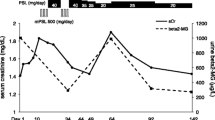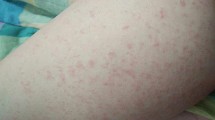Abstract
We report a case of allergic acute tubulointerstitial nephritis (TIN) induced by acetaminophen in a 48-year-old Japanese man with no past medical history. Two days after receiving the non-steroidal anti-inflammatory drug (NSAID) loxoprofen for left shoulder pain, he developed cold symptoms such as fever and sore throat. He then took a 300 mg dose of acetaminophen three times a day and a 100 mg dose of minocycline hydrochloride twice a day for 7 days. Because there was no improvement in his symptoms, he consulted a local clinic again, where blood tests revealed renal insufficiency, and he was, then, referred to our hospital for evaluation of kidney function. Renal biopsy revealed acute TIN, and Ga-67 scintigraphy showed diffuse uptake in bilateral kidneys. A drug-induced lymphocyte stimulation test (DLST) was positive for acetaminophen and negative for loxoprofen and minocycline. Based on these findings, we made a diagnosis of acetaminophen-induced TIN. We treated the patient with three courses of semi-pulse steroid therapy, after which his fever went down, and his serum creatinine level recovered from 2.09 to 1.43 mg/dL. Although we medical doctors think that therapeutic dose of acetaminophen retains high safety, it is important to keep in mind that acetaminophen can cause allergic acute TIN.
Similar content being viewed by others
Avoid common mistakes on your manuscript.
Introduction
Acetaminophen, also called paracetamol, is widely used as an analgesic and antipyretic agent around the world. Because of its safety, for all age groups and even for chronic kidney disease patients, acetaminophen is freely prescribed by many physicians and it is available as an over-the-counter drug at pharmacies.
It is well known that acetaminophen-induced nephrotoxicity and hepatotoxicity are sometimes seen simultaneously in cases of overdose [1, 8] or in alcohol intoxication [2, 3], but nephrotoxicity occurs in only 2% of who patients take an overdose [9]. Acute kidney injury (AKI) due to acetaminophen overdose is caused by circulatory failure and/or hepatorenal syndrome associated with acute hepatic failure, and is acute tubular necrosis pathologically. Although AKI is thought to be an extremely rare adverse effect of acetaminophen in healthy persons, therapeutic dose of acetaminophen sometimes impairs kidney function in patients who are glutathione depleted (chronic alcoholism, infants, starvation/fasting/malnutrition) or who take drugs that induce p450 proteins (smoking, isoniazid, chronic alcohol ingestion, anticonvulsants) [10]. It has been reported that therapeutic dose of acetaminophen sometimes induces both renal failure and hepatic failure [4, 5], but such cases are uncommon. Cases of renal damage induced by a therapeutic dose of acetaminophen without liver damage is very rare and mostly limited to children [6, 7], and such cases have hardly ever been reported in adults.
Case report
The patient was a 48-year-old Japanese man with no past medical history. Clinical course is shown in Fig. 1. He had a periodic medical checkup every year and was not pointed out of renal insufficiency before this episode. He had a habit of doing exercise every weekend and sometime used analgesic agents such as loxoprofen and poultice when he had myalgia and/or arthralgia due to overwork. In May 2013, two days after receiving loxoprofen for left shoulder pain, the patient developed cold symptoms such as fever and sore throat and consulted a local clinic, where a 300 mg dose of acetaminophen three times a day and a 100 mg dose of minocycline (MINO) twice a day for 7 days were prescribed. After taking these medicines, the patient was pointed out of renal insufficiency and found to have an elevated serum CRP level, and he was then referred to the Nephrology Division of the Yachiyo Medical Center of Tokyo Women’s Medical University, where he was admitted.
Physical examination on admission: body height 171.1 cm, body weight 63.6 kg, consciousness clear, blood pressure 112/77 mmHg, heart rate 57 beats/min, body temperature 36.1 °C. There was no lower limb edema, no skin rash, and no arthritis/arthralgia. Chest X-rays showed no evidence of pneumonia or pleural effusion and no other abnormal findings. An electrocardiogram showed normal sinus rhythm. A renal ultrasound examination showed no evidence of hydronephrosis.
The laboratory findings are shown in Table 1. Briefly, there was no proteinuria, hematuria, or eosinophilia. The urinary NAG, α1MG, and β2MG levels were elevated to 15.0 U/L, 42.6 mg/L, and 14.729 μg/L, respectively. The serum BUN level was 16.1 mg/dL, serum creatinine level 2.09 mg/dL, and serum CRP level 1.91 mg/dL, and the ESR was 68 mm/h. The calculated fractional excretions of sodium and urea were 1.18 and 48.4%, respectively.
The renal biopsy findings revealed tubulointerstitial nephritis (TIN) with eosinophil-dominant infiltration (Fig. 2). DLST was positive with high value of cpm for acetaminophen, but not for loxoprofen and MINO. Ga-67 scintigraphy showed diffuse uptake in bilateral kidneys (Fig. 3). Based on these findings we made a diagnosis of acetaminophen-induced TIN. We speculated that loxoprofen would be the candidate drug for acute TIN at first. But, we heard his lifestyle carefully and got an additional information that he had a habit of doing exercise every weekend. He told us that the frequency of joint and/or muscle pain due to overwork of exercise and usage of analgesic agents, such as loxoprofen and NSAIDs contained poultices, had been increased in recent years. From the clinical course when he could use loxoprofen safely so far, we concluded that the causative medicine was acetaminophen.
We conducted three courses of semi-pulse steroid therapy because the leukocyte infiltration of tubulointerstitial spaces was very severe. The serum creatinine level peaked at 2.09 mg/dL, but had fallen to 1.43 mg/dL at the time of discharge on the 29th hospital day. In addition, elevated tubulointerstitial injury markers such as NAG, α1MG, and β2MG improved. We tapered the dose of oral prednisolone, and discontinued it three months after discharge. The serum creatinine level was 1.36 mg/dL one year after discharge and 1.23 mg/dL two years after discharge.
Discussion
In a study conducted in 128 adults with a diagnosis of TIN, 70% of the cases were concluded to be due to adverse effects of drugs, that is, iatrogenic disorders, and a rash, fever and eosinophilia were observed in only 10% of the cases [11]. Confirmation of a diagnosis of TIN requires a renal biopsy. However, a renal biopsy was not performed in many cases clinically diagnosed with drug-induced renal insufficiency. The typical light microscopic finding of TIN is lymphocyte-dominant inflammatory cell infiltration in tubulointerstitial lesions. Eosinophil infiltration is more prominent in drug-induced TIN [12]. Our case showed marked eosinophil infiltration that is consistent with drug-induced TIN. TIN is also associated with autoimmune diseases such as Sjögren’s syndrome and systemic lupus erythematosus, however, these diseases were ruled out in our case. To our knowledge, there have been only four adult cases including our own case of biopsy-confirmed TIN induced by a therapeutic dose of acetaminophen [5, 13]. In the cases administrated several medications simultaneously it might be very difficult to specify the causative drug. To determine a causative drug in candidate drugs, there are DLST and drug-allergy induction tests such as patch test, prick test, and challenge test. However, the former has low sensitivity, and the latter may be ethically unacceptable.
The basic treatment for drug-induced TIN is supportive therapy, such as body fluid and electrolyte management [14]. Although the effectiveness of steroid treatment in drug-induced TIN is controversial, some studies have shown efficacy of introduction of steroid treatment in the early phase [15,16,17,18]. We treated our patient with steroid because there was severe infiltration of inflammatory cells in the renal biopsy specimens and the elevated ESR/CRP levels reflected organ inflammation.
We concluded that the evidence in our case indicated that acetaminophen could cause allergic acute TIN. Because of its safety, many physicians tend to prescribe acetaminophen freely, and it is available as an over-the-counter drug at pharmacies. Although AKI has been reported in 0.4% as its side effect of acetaminophen [16], we medical doctors assume that the incidence of AKI is lower than reported. Allergic drug-induced TIN is an adverse effect of a medication developed in a dose-independent manner. Since acetaminophen is the representative drug that all people can be given, physicians need to be aware that even a therapeutic dose of acetaminophen can cause allergic acute TIN.
References
De Broe ME, Elseviers MM. Analgesic nephropathy. N Engl J Med. 1998;338:446–52.
Furchter LL, Alexopoulou I, Lau KK. Acute interstitial nephritis with acetaminophen and alcohol intoxication. Ital J Pediatr. 2011;37:17.
Blalely P, McDonald BR. Acute renal failure due to acetaminophen ingestion: a case report and review of the literature. J Am Soc Nephrol. 1995;6:48–53.
Satirapoj B, Lohachit P, Ruamvang T. Therapeutic dose of acetaminophen with fatal hepatic necrosis and acute renal failure. J Med Assoc Thail. 2007;90:1244–7.
Kato H, Fujigaki Y, Inoue R, Asakawa S, Shin S, Shima T, Furunishi J, Higaki M, Tanemoto M, Yamaguchi Y, Hoshimoto K, Uozaki H, Uchida S. Therapeutic dose of acetaminophen as a possible risk factor for acute kidney injury: learning from two healthy young adult cases. Intern Med. 2014;53:1531–4.
Ozkaya O, Genc G, Bek K, Sullu Y. A case of acetaminophen (paracetamol) causing renal failure without liver damage in a child and review of literature. Ren Fail. 2010;32:1125–7.
Gallego N, Teruel JL, Mampaso F, Gonzalo A, Ortuno J. Acute interstitial nephritis superimposed on glomerulonephritis: report of a case. Pediatr Nephrol. 1991;5:229–31.
Boyer TD, Rouff SL. Acetaminophen-induced hepatic necrosis and renal failure. JAMA. 1971;218:440–1.
Prescott LF. Paracetamol overdosage: pharmacological considerations and clinical management. Drug. 1983;25:290–314.
Blakely P, McDonald BR. Acute renal failure due to acetaminophen ingestion: a case report and review of literature. J Am Soc Nephrol. 1995;6:48–53.
Baker RJ, Pusey CD. The changing profile of acute tubulointerstitial nephritis. Nephrol Dial Transplant. 2004;19:8–11.
Alon US. Tubulointerstitial nephritis. In: Avner ED, Harmon WE, Niaduet P, Yoshikowa N, editors. Pediatric nephrology. 6th ed. Berlin: Springer; 2009. p. 1081–98.
Tang Y, Yang L, Tao Y, Qin W. A case of acetaminophen-induced acute interstitial nephritis and other complications. Clin Nephrol. 2015;84:118–9.
Kodner CM, Kudrimoti A. Diagnosis and management of acute interstitial nephritis. Am Fam Physician. 2003;67:2527–34.
González E, Gutiérrez E, Galeano C, Chevia C, de Sequera P, Bernis C, Parra EG, Delqado R, Sanz M, Ortiz M, Goicoechea M, Quereda C, Olea T, Bouarich H, Hernadez Y, Seqovia B, Praga M. Early steroid treatment improves the recovery of renal function in patients with drug-induced acute interstitial nephritis. Kidney Int. 2008;73:940–6.
Galpin JE, Shinaberger JH, Stanley TM, Blumenkrantz MJ, Bayer AS, Friedman GS, Montgomerie JZ, Guze LB, Coburn JW, Glassock RJ. Acute interstitial nephritis due to methicillin. Am J Med. 1978;65:756–65.
Buysen JG, Houthoff HJ, Krediet RT, Arisz L. Acute interstitial nephritis: a clinical and morphological study in 27 patients. Nephrol Dial Transplant. 1990;5:94–9.
Pusey CD, Saltissi D, Bloodworth L, Rainford DJ, Christie JL. Drug associated acute interstitial nephritis: clinical and pathological features and the response to high dose steroid therapy. Q J Med. 1983;52:194–211.
Author information
Authors and Affiliations
Corresponding author
Ethics declarations
Conflict of interest
All the authors declared no conflict of interest.
Human rights
This article does not contain any studies with human participants performed by any of the authors.
About this article
Cite this article
Inoue, D., Usui, R., Nitta, K. et al. A case of acetaminophen-induced acute tubulointerstitial nephritis in adult. CEN Case Rep 6, 185–188 (2017). https://doi.org/10.1007/s13730-017-0272-3
Received:
Accepted:
Published:
Issue Date:
DOI: https://doi.org/10.1007/s13730-017-0272-3







